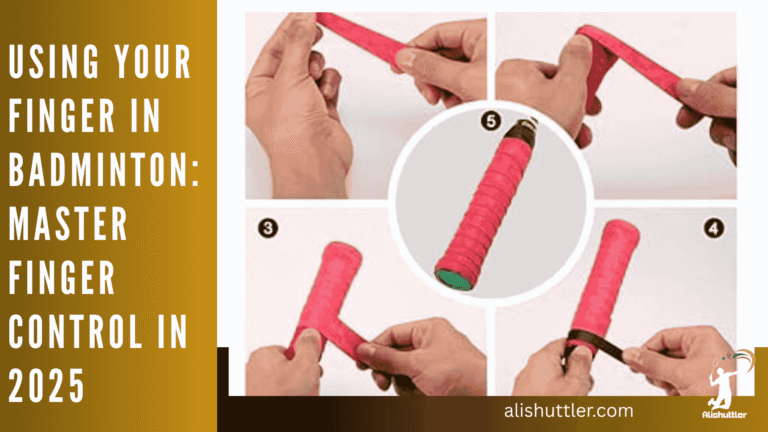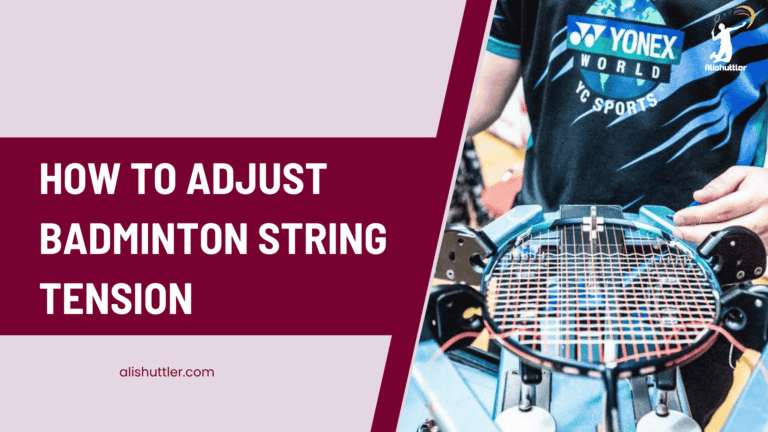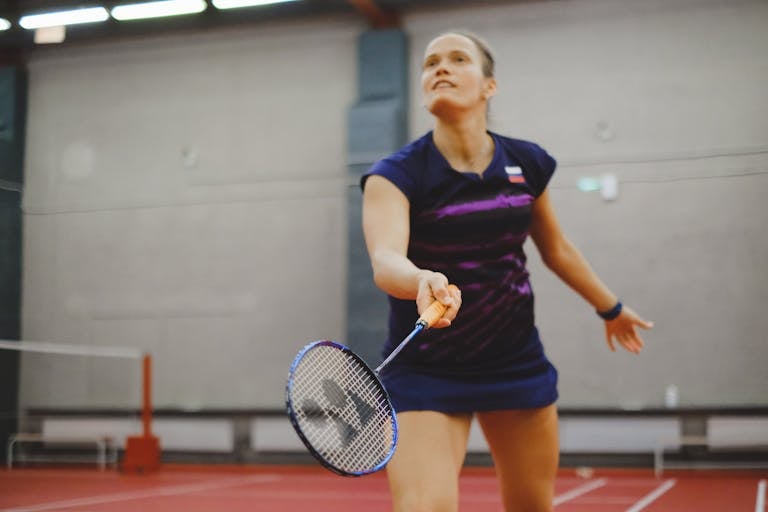A clear or lob in badminton is a high, deep shot to the rear of the opponent’s court. Players apply this stroke to develop open space, to regenerate rallies, or to push opponents off the net.
The clear can be executed using a forehand or backhand grip. It protects you from smashes and maintains equilibrium in play.
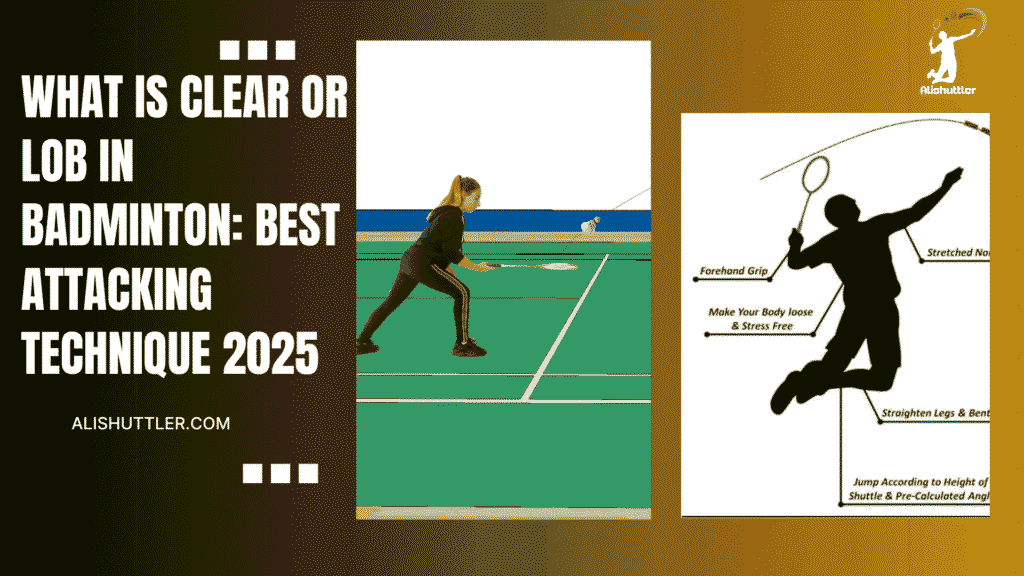
It’s this knowledge of when and how to hit a clear or lob that forms the basis of solid badminton strategy.
Shot Definitions
In badminton, a clear, or lob, is a high shot sending the shuttle deep into the opponent’s backcourt. These shots serve to slow down the rally, control court space and allow players an opportunity to reset.
Both clear and lob shots are great for keeping an opponent off balance and can be played with different techniques for strategic advantage.
| Shot Type | Key Features | Benefits | Role in Game |
|---|---|---|---|
| Clear (Forehand/Backhand) | High, deep to back court, varied speed | Creates space, defensive recovery | Controls rally pace, resets position |
| Lob | High lift over opponent’s head | Defensive, pushes opponent back | Disrupts rhythm, buys recovery time |
The Clear
A forehand clear shot is executed with a straight arm action, swinging the racket overhead with a follow-through to propel the shuttlecock high and long. This stroke begins with the player turning their side to the net, balancing their body with the non-racket hand, and hitting the shuttle with an open racket face to generate maximum height and distance. Mastering the basics of badminton shots is essential for effective gameplay.
Wrist rotation is key for the backhand clear. The player stands about sideways, brings the racket across his body, and flicks his wrist swinging a tad upward. This action assists in popping the shuttle up and over the opponent’s reach, even from difficult positions. Understanding different types of clear shots can enhance a player’s defensive badminton tactics.
The backhand clear is particularly handy when players are pulled wide on their weak side. Height and distance are what count most with a clear. The higher and deeper the shuttle lands, the more time the player has to get back. By utilizing effective defensive lifts, players can regain control of the rally.
A good clear pushes the other team back, sometimes even causing them to panic. Clear shots clear the court. They can push your opponent to the back court — opening up the front court and allowing you to prepare for the next phase of the rally, ultimately leading to point winners.
The Lob
Lob shots are mostly defensive. They drive the adversary to the rear of the court, providing the player with breathing room and a moment to recompose.
Players can fire a lob from close to the net or mid-court or baseline – wherever they find themselves when in trouble. Each position varies the direction and height of the lob, however, the primary objective remains to lob high and far.
Good timing and footwork is the key. The player must judge the shuttle’s descent, footwork into position and attack with a fluid upward swing. Nice timing = less likely to get hit with a quick strike.
Lob shots frequently disrupt the other person’s rhythm. When well placed they can disrupt an aggressive player’s cadence and induce slower, loftier returns.
Technical Execution
Clear and lob shots in badminton, including the badminton lob and defensive badminton clear, require you to focus on minor details. Everything — grip, stance, swing path, footwork, and contact point — contributes to how well the shot technique works.
1. Grip
A loose grip is essential for executing various badminton shots effectively. This aids quick turning and provides superior tactile feedback when handling the shuttlecock. A death grip can lead to stiff swings and diminished control. Experimenting with forehand and backhand grips can significantly alter your shot’s height or distance, especially when transitioning between a clear shot and a badminton lob. Players often find that a grip with a little tack enhances their ability to adjust during rallies.
Make it a habit to change your grip when moving from a defensive badminton clear to a lob or back to forehand. This grip awareness can be a game-changer in match play. The correct grip can also influence the trajectory of your shots. For executing a high, deep clear, shake hands with the racket—keeping fingers loose and the thumb along the side. For a lower lob, adjust your fingers so the thumb is positioned behind the handle.
Testing what feels right is crucial. Spend time hitting with both grips to identify the optimal combination of control and comfort for your badminton lifts. This practice will enhance your overall performance and adaptability during matches.
2. Stance
Begin with your feet shoulder-width apart and knees bent, placing your weight on the balls of your feet. A balanced stance allows for quick lateral movements, essential for executing effective badminton shots. Ensure your feet are slightly turned out to enhance your lateral action. This smart stance not only aids in reaching for overhead clears but also stabilizes you for defensive badminton lifts, crucial during intense rallies.
Stay light on your toes to respond swiftly to quick shuttlecock movements. You’ll find that solid stance habits lead to more powerful shots and fewer mistakes. Adjust your stance according to the type of shot: adopt a staggered stance for overhead clears and a square stance for underhand lobs. Repeating these modifications will help develop muscle memory, making you more adept at executing various badminton techniques.
Repeat these modifications until you develop muscle memory. Little stance adjustments can optimize your play. Fast shuffles or split-steps after every shot keep you prepared for the next return.
3. Swing Path
For clear shots, a long, smooth swing is best. Begin with your racket behind your shoulder, finish overhead. For a lob, swing up in a soft arc. Keep your arm straight to really get the shuttle high and deep. The angle of your racket head varies the shot; tilt it up for a high clear and flatter for a lower lob.
Work on swinging at a consistent pace. Fast swings provide power, but control is first. Drill with a partner feeding half-court clears to perfect your motion. Experiment with alternative strings, such as BG80, for increased bounce and enhanced feel.
4. Footwork
Good footwork gets you where you need to be, when you need to be there. Fast feet take you to backcourt for a clear or get under the shuttle for a lob. Employ shadow drills or ladder work to construct your speed. Jump rope can enhance your lightness on court.
Neat footwork translates to improved timing on every shot. If you’re already making the shuttle quick, zero in on your shot form. Legs and core that are strong make movement flow. Little steps prior to impact hold you steady.
Split-step as your opponent strikes — this assists you to respond quickly. Stay ready on your toes.
5. Contact Point
Hit the shuttle where you can reach it at the very highest point. For clears and lobs, the prime contact zone is right above your head. The higher you strike it, the better it’s easier to clear the shuttle deep. Wait too long, and you cede power.
Strive to catch the shuttle early. This allows you additional time to recuperate. Try whacking a squash racket or build up your wrist with dumbbell lifts to aid timing and power.
A checklist for practice could look like this:
- Check grip before each shot
- Set feet for the right stance
- Swing high and smooth
- Move fast to position
- Hit shuttle at peak height
Strategic Purpose
Clear and lob shots remain foundational weapons in badminton strategy. Both shots allowed players to sculpt the pace of rallies, purchase time and put their opponents in tough positions. When used correctly, they create openings for smashes, drops, or net kills, and facilitate transitioning from defense to offense.
The clear, in specific, is a singles player’s must-know and is crucial for establishing an all-around game.
Strategic advantages of clear and lob shots:
- Control the pace of rallies and reset positions
- Push adversaries back from the pin and into the rear guard
- Create openings for smashes, drops, or net kills
- Aid bounce back and buy time for shot selection
- Disrupt opponents’ rhythm, making them more prone to errors
- Create attacks by setting the shuttle deep and wide
- Reduce the effectiveness of net play and flat drives
Attacking Clear
Smashes force opponents to defend and net kills surprise them. When delivered with depth and pace, these shots can pull the opposition’s defense out of position and open up space for the follow-up strike. A properly positioned attacking clear, landing close to the baseline, is difficult to hit back with force.
Depth and precision are what count. If the shuttle is short, your opponent can smash or drive it. Striking the clear at an opportune time when the opponent anticipates a drop or smash can surprise him and compel a feeble response.
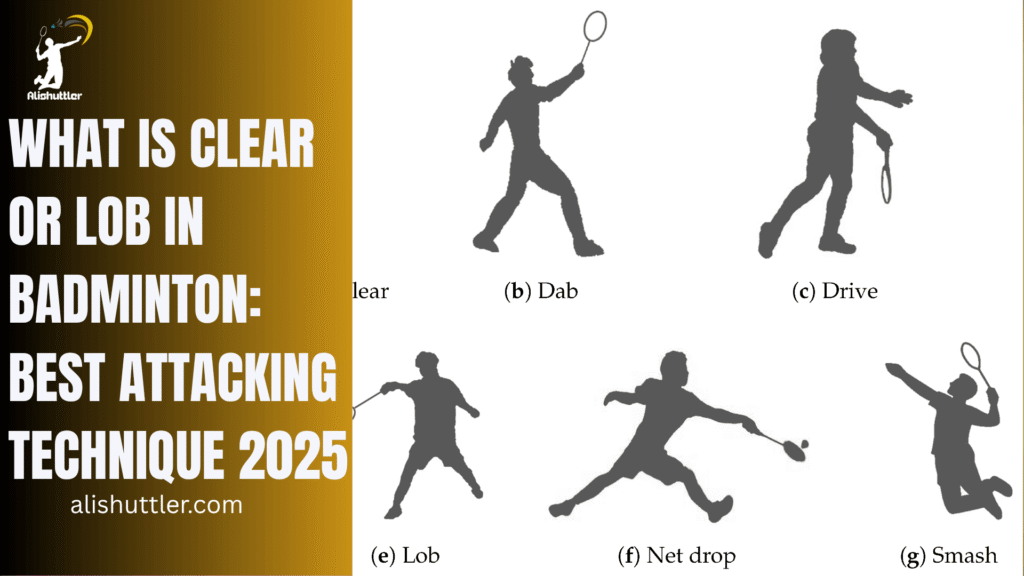
Use attacking clears as part of a plan: follow up with a drop shot or a smash once the rival is trapped at the back.
Defensive Clear
A defensive clear disrupts the opponent’s offense and allows you to reset, particularly when on the ropes. By shuttling high and deep to the back court, he gains time to reset and plot the next play. This is key in singles play, where space is at a premium.
Precision and power are essential, so the shuttle falls near the baseline, far from easy strikes. If the clear is weak, the opponent can drive it back.
With defensive clears that push opponents into the back court, reducing their angles and making it harder for them to push. Use them to reset and prepare for the next shot.
Offensive Clear or Lob in Badminton
The offensive lob can reverse the tide. A timely lob, executed with a touch of deception, sends the opponent retreating when they’re anticipating a net or drop shot. This disruption of rhythm can open up room and induce errors, particularly in doubles play.
Surprise is the primary instrument. The lob is best played from the front or mid-court, with a quick wrist and soft touch. Timing and location are crucial, so the shuttle arrives deep but not out to Clear or Lob in Badminton.
By incorporating the offensive lob into the attack, you keep opponents off balance and provide the possibility of a net kill or drive shot.
Defensive Clear or Lob in Badminton
Defensive lobs repel the opponent and provide you with breathing room. These shots are convenient in grueling rallies, allowing the player to decelerate and check things. A good lob can break up an opponent’s net pressure and send them scrambling to the baseline.
Good lobs have a tall, deep trajectory and never, ever come up short. If it hit soft, the competitor could crush.
Drill lobs from both wide spots and tight angles to prepare for all areas of the court.
Situational Use
Clear or Lob in Badminton shots aren’t restricted to a single style of play they belong in many match scenarios. Players can toggle between defense and attack use, as needed. Both shots allow you to take control of the rally, to reset the pace, or to apply pressure on the opponent.
Smart players consider the court, the score, themselves and their opponent’s habits before selecting such shots.
- Use a clear to push your opponent to the rear, clearing the front court.
- Lob to disrupt your opponents rhythm or slow play down for recovery.
- In quick exchanges, a clear has the ability to reset the tempo and maintain your dominance.
- Both shots can surprise the opponent, leaving less time to answer.
- In doubles, lobs can open up holes for your partner to pounce on.
- An incomplete lob may assist if you’re out of position, but it’s dangerous.
- Figure out your opponent’s strong and weak areas prior to deploying these shots.
- Modify tactics for singles or doubles play for optimal performance.
Against Attackers
A clean shot comes in handy when confronting a crazy attacker. It drives your opponent back to the rear court, breaking their net play rhythm. Caught at the right moment, this shot can reset the rally, providing you a much-needed reprieve while forcing your opponent to scrap to maintain their furious pace.
Lob shots are effective when you want to decelerate the game and irritate attackers. A well-placed lob breaks their rhythm, forcing them further back and providing fewer angles to end the rally abruptly. Therefore, timing does matter for Clear or Lob in Badminton.
A Clear or Lob in Badminton, played just as the attacker is about to pounce, can transform the rally in your direction. Attempt to anticipate the attacker’s attack. Anticipate where they’re going, then lob or use a clear to put them in awkward positions.
Against Defenders Clear or Lob in Badminton
Attacking clears assist in penetrating formations by lobbing to the corners or sides. In addition to points, these shots can push defenders out of their comfort zone and create room for follow-up attacks.
Deceptive lobs, such as a disguised drop shot or a driving overhead, can push defensive players to run forward and back, preventing them from finding a rhythm. Hang in there and focus on smart shot placement.
No hurry. Stir in various clears and lobs to keep defenders off balance. The trick is to not be predictable and to watch for any holes in their coverage.
In Doubles
Clear and lob shots are less common in doubles than in singles, but they remain important. A perfectly placed lob can drag both opponents to the back court, allowing your partner to step in for a net kill or a hard smash.
Communication is key. Partners have to decide when to lob or clear and be prepared to rotate quickly. Drills that practice employing these shots in doubles, for example, cross-court lobs or fast clears, can help both players cover the court and strike when the opportunity presents itself.
In Singles Clear or Lob in Badminton
Clear and lob shots provide singles players with a means of controlling the rally’s tempo. You can send them back to shoo back the opponent, establish some net front space or just decelerate to catch your breath.
Watch your opponent’s feet. If they advance, an obvious drive can send them back. If they loll near the back line, go for a drop shot. Keep yourself open to transformation.
Like everything else, the best singles players use clears and lobs in many different ways, flexing to each rally. Eventually, you’ll discover a style that suits your strengths and frustrates your opponent.
Training Drills
Clear or lob shots badminton training drills help badminton players gain control, power and smart-play on the court. Various drills develop abilities such as accuracy, muscle memory and feints. The majority of drills are optimal with a partner, a few can be performed solo.
Safety first–Partners should remain on one side of the net and hit into an open court. This arrangement reduces the chance of harm and allows athletes to concentrate on technique and outcomes. Tracking progress, self-grading, and receiving feedback increase that effectiveness.
Precision for Clear or Lob in Badminton
To develop accuracy, position small targets deep in the backcourt. Strike clear or lob shots and attempt to drop the shuttle on or near these. Rotate the targets’ placement so they cover various areas of the court, such as corners and middle.
This gets players shifting their shot from all regions, not just the baseline. Hit these drills from both left and right sides, with forehands and backhands. It’s crucial to maintain your racket hand cocked up behind your head, and your hips dropped in a squat, to establish every shot.
Steady repetition cements muscle memory and shot precision. Monitoring how many shots land on target every session inspires consistent development and identifies weak areas.
Power for Clear or Lob in Badminton
Power drills begin with strength training–lunge, squat and core work with body weight. These moves enhance the foundation for powerful shots. Then, practice correct form.
Power is generated by a full swing of the entire body, not the arm alone. Push with the legs, turn the hips, and whip the wrist at contact. Training with heavier shuttles develops arm strength and velocity.
Don’t forget to complete each swing. A strong finish on each shot projects the shuttle further. Keep your stance balanced with a soft knee bend for support.
Deception
Exercise makes trickery easier. Practice to mask your shot by lining up the same for every shot, then shifting speed or angle at the last moment. Experiment with slowing your swing or a sweet wrist flick for softer lobs.
Deceptive footwork addition keeps opponents off balance. Take little steps and weight shift to disguise your next move. Mixing up shot height and path, while attempting to look identical until the final moment, provides you that added advantage.
Consistency on Clear or Lob in Badminton
Shoot the same shot, in sets of 10 or 15. Establish a target, such as landing 8 of 10 shots to a specific location. Concentration is everything shut out extraneous thoughts and do the fundamentals.
Maintain a basic log for each drill. See how many shots made the mark. Take quick notes or short videos to review yourself. Minor variations in your stance, swing or footwork can alter your outcome.
Evolving Philosophy
The biomechanics of how badminton players conceptualize clears and lobs, including the importance of defensive badminton techniques, have evolved significantly. Influenced by sports biomechanics research, modern coaching emphasizes the execution of badminton lifts and shot variations, allowing players and coaches to adapt to evolving play styles with a focus on movement and strategy.
Historical View of Clear or Lob in Badminton
Clear and lob shots have long been badminton staples to create time, reset rallies, or push opponents back. In those days, the form was more rigid, players utilized a high, arcing swing with less speed and emphasis on deception. The point was to physically push the opposition, not to disguise intent or shift speed. Today, mastering different types of badminton shots, such as the defensive Clear or Lob in Badminton, is essential for players aiming to outplay their opponents.
Over time, methods got crisper. Footwork, grip changes, and wrist use became increasingly critical. Players like Indonesia’s Liem Swie King and Susi Susanti popularized these shots with their graceful flair and precision. Their rallies demonstrate how one well-placed clear shot can open the opportunity for a winning smash or disrupt an opponent’s flow.
If you examine vintage games, you observe how a well-sited clear could shift the match momentum, particularly in the pre-fast rally and attacking days.
Modern Interpretation
Now, the Clear or Lob in Badminton require something beyond height and length. Velocity and camouflage and location are important. Contemporary players employ a combination of quick and slow clears, occasionally incorporating slice or jump to mask their real purpose.
Next-gen drills employ 3D motion capture and dynamic body modeling to dissect every component of the shot, from grip to follow-through. This reveals to players where they waste strength or telegraph their moves to adversaries.
Technology assists coaches to observe trends, identify vulnerabilities, and discover innovative methods to train reaction time and deception. Adjusting to quick, aggressive styles requires players to swap shot selections on the fly, occasionally hitting a punch clear or reverse slice.
Being up to date means watching pro matches, leveraging data, and experimenting with new drills to keep up with trends.
My Perspective
Clear or Lob shots in Badminton aren’t merely time-buying; they help you control pace and set up attack or defense. Mastering them altered my strategy, enabling me to disrupt quick exchanges or coax errors from foes that get too aggressive at the net.
It’s not about mimicking top players, but experimenting, observing what works and adjusting tactics slightly based on feedback or match outcomes.
| Impact on Gameplay | Description |
|---|---|
| Better control of rallies | Choose when to attack or defend |
| Improved deception | Harder for opponents to guess next move |
| Lower injury risk | Smoother movement, less overreach |
| More confidence under pressure | Can reset and slow down tough points |
Personal Reflection
Gamers shouldn’t cling to habits. Instead, employ new knowledge, consider matches, and adjust your strategy accordingly. Each individual’s journey is different, carved out by their own play and discovery.
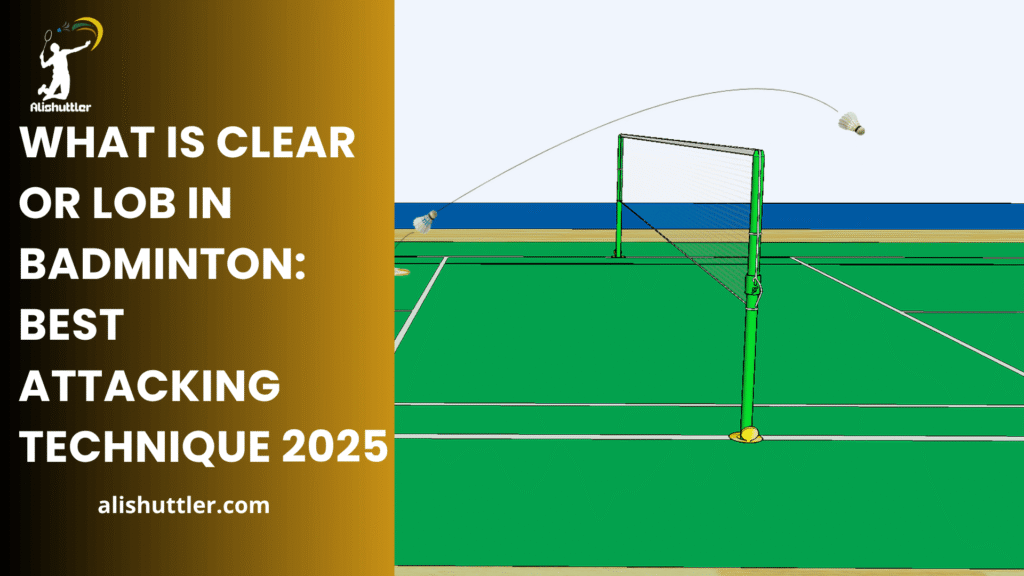
Build on what works, drop what doesn’t. Try, fail, and try again.
Final Thoughts on Clear or Lob in Badminton
Clear and lob shots frame a Clear or Lob in Badminton play. Both open up space, reset the pace, and stretch an opponent’s reach. Each shot plays best in its way, clear to push the other player back, lob for a quick change, or to break the pressure. Both require good footwork, clean hitting, and sharp timing.
Drills build these skills, but real matches bring out their best usage. Badminton keeps evolving, and these strokes remain critical. To improve, attempt both in matches and practice. Vary your shots, observe what’s effective, and keep your game fresh. For additional tips or drills, watch coaching videos or become a member of a local club.
Frequently Asked Questions
What is a clear or lob in badminton?
A clear shot or lob shot is a high deep shot from one end of the court to the other, helping to push your opponent to the back and giving you time to return to a defensive badminton position.
How do you execute a Clear or Lob in Badminton correctly?
Use a loose grip, swing up with a full arm, and hit the shuttlecock at the highest point for an effective badminton smash. Aim for the opponent’s backcourt to maximize height and distance.
When should I use a clear or lob in a game?
Use defensive badminton techniques when you’re under pressure or need to reset your position; they are great for dragging your opponent away from the net.
What is the strategic purpose of a clear or lob?
The clear shot or lob shot opens up space, pushes opponents to the rear court, and disrupts their offensive strategy. This tactic allows you to regain control of the rally effectively.
Are there different types of clears or lobs in badminton?
Yup, there are attacking clears, which are fast and flat, and defensive badminton clears, which are high and deep. Each has a different tactical intent.
How can I practice clear or lob shots effectively?
Practice on repetition drills focusing on different types of badminton shots, including lift shots and net shots, while concentrating on technique, height, and placement.
Why is mastering the clear or lob important for beginners?
It’s a basic defensive badminton shot that builds court awareness, stamina, and control of pace.

